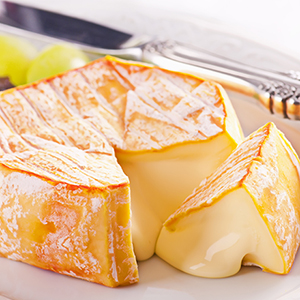- Cook cream cheese, it's a breeze
- Quebec Cheeses to Discover
- Selecting and Storing Cheeses
- Time For Quebec Cheese
- Classification of Cheeses
- Artisanal Cheeses
- Au Gratin, Stuffing, Dessert… How to Choose the Right Cheese
- Learn How To Serve Cheese
- Make Your Cheese Tasting a Success
- More Cheese Please!
- Cooking with Cheese
- Cheese on the menu
- Apple Cheese Pairings
Classification of Cheeses

Did you know there are about 2000 varieties of cheeses in the world? We clearly can’t get enough of this tasty food! A visit to the cheese counter is a fun exploration to discover new types each time. Three main characteristics are taken into account when grouping cheeses: the type of rind, the humidity content and the fat content.
Types of Rind
There are three types of cheese rinds: bloomy, washed and artificial. The rind plays an important role in categorizing the various types of cheeses and determines the length of time a cheese can be stored, its aroma and its potency. Mixed and smeared rinds are progressive, which means that they will change in colour, aroma and flavour as the ripening process evolves.

Bloomy rind

The surface of the rind is seeded with penicillium candidum, which covers the curd with a velvety-white duvet called a “bloom”. Over time, the rind darkens to brown; it can be eaten or not. The flavour of the rind is different from one soft curd to another.
Washed rind
As a rule, this rind is washed with water, wine, beer, a salty solution or brine and bacteria. This edible rind is slightly humid and has a strong odour.
Artificial rind
An artificial rind can be made from organic material such as herbs, non-organic material such as paraffin, wax, wood ashes, or it can even be painted with food colouring.

Humidity
The humidity content in a cheese varies from less than 35% to over 60%. Cheeses with the highest humidity levels are fresh cheeses like cottage cheese, while those on the opposite end of the humidity scale are hard-curd cheeses like Parmesan.
Here is a list of cheese types according to humidity level.
- Fresh cheese: Over 60% humidity
- Soft cheese: 50% to 60% humidity
- Semi-firm cheese: 45% to 50% humidity
- Firm cheese: 35% to 45% humidity
- Hard cheese: Less than 35% humidity
Fat
The fat content of cheese plays a major role in determining the intensity of its flavour. Cheeses with higher fat content include Cheddar, Brie, Stilton and mozzarella, while ricotta and cottage cheese are considered lower in fat. However, many traditional high-fat cheeses have light variations as well!
Take A Dip Into Cheese















